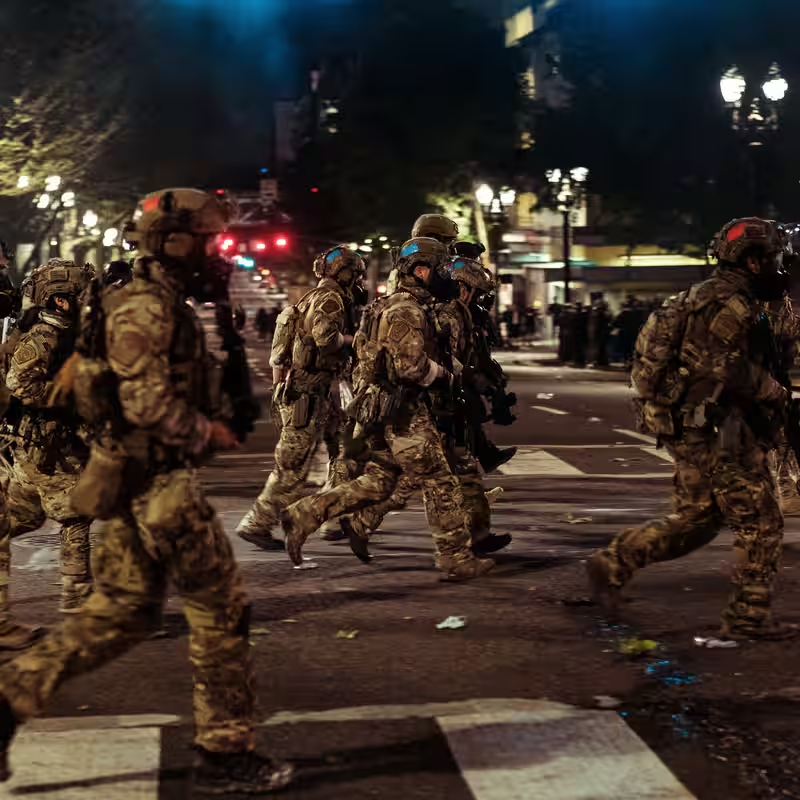When President Donald Trump deployed federal agents to Portland in 2020 to quell Black Lives Matter protests, he didn’t calm the streets—he poured gasoline on the fire. Now, as Trump eyes cities like Chicago and Memphis for similar interventions, Portland’s chaotic summer offers a stark warning: heavy-handed federal force often backfires, escalating tensions instead of resolving them.
Table of Contents
- What Happened in Portland in 2020?
- Lesson 1: Federal Forces Escalate Tensions
- Lesson 2: Extremists Thrive in Chaos
- Lesson 3: Messaging Matters—A Lot
- Lesson 4: Isolated Police Lose Control
- Lesson 5: The Original Cause Gets Lost
- Sources
What Happened in Portland in 2020?
In June 2020, after weeks of nationwide protests over George Floyd’s murder, demonstrations in Portland had dwindled to a few hundred people nightly. But when the Trump administration launched “Operation Diligent Valor” and sent Border Patrol, ICE, and DHS agents to guard the federal courthouse, tens of thousands returned to the streets—many now protesting the federal presence itself.
Clad in unmarked uniforms, federal agents used tear gas, impact munitions, and aggressive arrests. The result? Violent clashes, national outrage, and a city branded as “lawless”—even though most protests remained peaceful by day.
Lesson 1: Federal Forces Escalate Tensions
Local police are trained in de-escalation and crowd management. Federal agents? Not so much.
“Taking people whose job is being a border patrol agent at the southern border and asking them to do urban crowd control—that’s just not going to succeed,” said Portland Police Sergeant Aaron Schmautz.
In 2020, the sudden arrival of federal troops acted like a magnet, drawing counterprotesters, media, and agitators. What had been a contained local issue exploded into a national flashpoint. Today, as Trump threatens to send National Guard units to Chicago, experts warn history could repeat itself.
Lesson 2: Extremists Thrive in Chaos
While the vast majority of Portland protesters were peaceful, a small group of anarchists used the chaos to justify violence—throwing rocks, setting fires, and damaging property. Federal agents responded with even greater force, creating a dangerous feedback loop.
“Embedded in that crowd were people willing to set a building on fire with people in it,” said Renn Cannon, former FBI special agent in charge for Oregon. “From a law enforcement perspective, that’s where I had to focus.”
The lesson? When federal presence inflames tensions, it creates space for extremists on both sides—left and right—to hijack the narrative.
Lesson 3: Messaging Matters—A Lot
Trump repeatedly called Portland a “war zone” burning to the ground—even though protests were confined to a six-block radius. That narrative stuck, scaring tourists, investors, and even relatives in Georgia.
“You can roll your eyes all you want,” said sociologist Randy Blazak, “but perception matters.”
This time, Oregon leaders are fighting back with facts: hosting media briefings on the waterfront, sharing business impact reports, and emphasizing that Portland remains safe for daily life. For cities like Memphis or Chicago now in Trump’s crosshairs, controlling the story may be as crucial as controlling the streets.
Lesson 4: Isolated Police Lose Control
In 2020, Portland’s City Council barred local police from coordinating with federal agents—a well-intentioned move that backfired. Officers couldn’t share intelligence, de-escalate situations, or distinguish peaceful marchers from violent agitators.
“We were just very isolated in many ways—from our City Council, from our state government, from the people out protesting,” said then-Chief Bob Day.
Today, Portland has reformed its approach: “dialogue officers” now liaise with protest organizers, and police wear soft uniforms instead of riot gear near sensitive sites. In Chicago, where local police were recently tear-gassed alongside civilians during an ICE operation, the need for coordination is urgent.
Lesson 5: The Original Cause Gets Lost
The 2020 protests began as a call for racial justice and police accountability. But once federal troops arrived, the message shifted entirely: “Get Trump out.”
“A lot of the work we’d done to dismantle white supremacy got sold out,” said activist Teressa Raiford. “The priority was, ‘We’ve got to get rid of Trump.’”
Five years later, as new protests erupt over immigration raids and ICE facilities, Portlanders fear the same pattern: a righteous cause drowned out by political theater and presidential provocation.
As Trump eyes more cities for intervention, Portland’s experience isn’t just history—it’s a playbook for what not to do.




